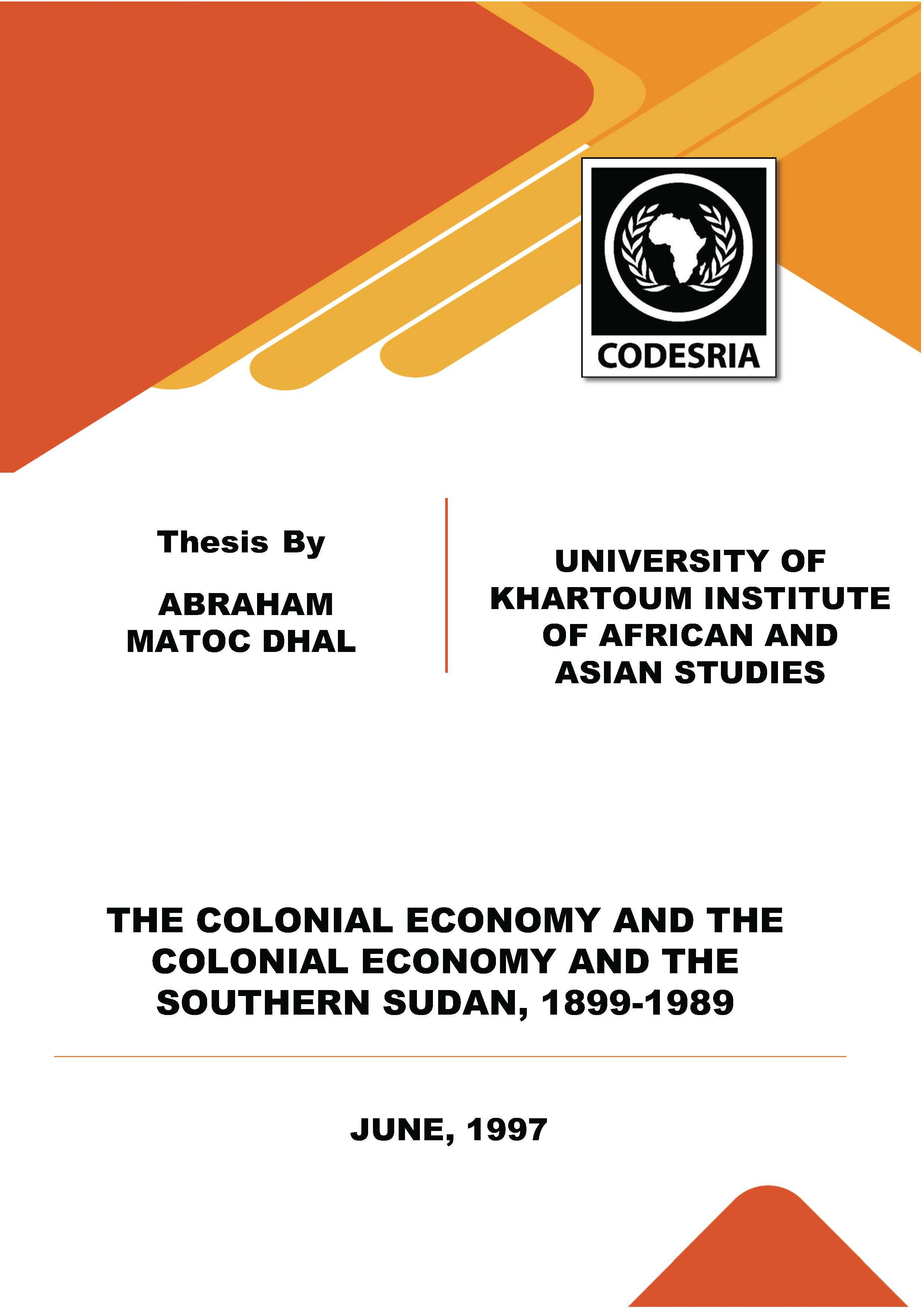The colonial economy and the underdevelopment of the southern Sudan, 1899-1989
Keywords:
Underdevelopment, development plans, national policy, economic development, colonialism, independance, economic policy, colonial economy, Southern Sudan, SudanSynopsis
This study analyses socio-economic underdevelopment of Southern Sudan during the colonial and post independenceperiod, 1899-1989. The phenomenon of underdevelopment is critically examined, and an explanation of the existing under-development conditions in the southern Sudan is made. Accordingly, the research attempted to investigate four main issues: causes of underdevelopment of the Southern Sudan from the colonial period to the independence, factors contributing to, and responsible for, the economic imbalance between Northern~nd Southern Sudan; adverse colonial policies inherited by thesuccessive governments of independent Sudan, which have led to persistent underdevelopment in the Southern Region; and the national governments' economic policies toward development of the Southern region during post independence. The findings show that the colonial rule militated against the develop1nent of the Southern Sudan by denying the region · the opportunity to exploit its rich natural resources. The colonial philosophy was based on the assertion that the Southern region is poor and unworthy of any economic investment. This implied that the British administration discouraged development in the region . The descriptions it gave about the Southern region is that it- is a jungle, swampy and. unfit for human living but for animals and mosquitos. Such claims are unacceptable. This research indicates that southern Sudan is rich in natural resources. The thesis contends that this unjust campaign has affected the post independence economic · policies. Consequently, the successive governments had to invest more resources to improve long staple cotton in Gezira in .Northern Sudan which was the colonial legacy; traditional agriculture in the south was neglected on the account of this campaign. Also economic and social services· were concentrated in the North, creating an increased economic and social imbalance between the Northern and Southern Sudan. Hence the· persistence of the underdevelopment of the Southern Sudan during the post independence era; collapse of national projects (Tonj kenaf; Wau fruit factory, Melut sugar factory, and Nzara factory; insufficient social and economic services; lack of banks and credit institutions to support traditional farmers; and the poor industrial sector witnessed in the Southern region. This confirms the claims that Southern Region has been deprived of development by uneven distribution of the state's resources for development rather than · lack of them.
Downloads
References
Ah1ned, M. M. M. (ed), Indigenous Farming Systems, Knowledge and . Practices in the Sudan, IAAS, University of Khartoum, 1994.
Alier, Abel, Southern Sudan, Too Many Agreements Dishonoured, Ithaca Press Exeter, Exeter, 1990.
Ali, A. Abdel Gadir (ed).The Sudan Economy 1n. Disarray. Essays On the IMF Model, Khartomn, 1985.
Ali, Taisier Mohamed A.., The Cultivation of Hunger, State and Agriculture in Sudan, Khartoum University Press, Khartoum, 1989.
Al Teraifi, Al-Agab (ed), Decentralization in Sudan, Graduate Collage Publication No. 20, University of Khartoum, 1987.
Arou, Mom K.N. and Yongo-Bure, B. (eds),North-South Relations in the Sudan Since the Addis Ababa Agreement, Sudan Library Series (14), IAAS, University of Khartoum, 1988.
Awad, Mohamed Hashim, The Socio-Economi: Change in the Sudan, University of Khartoum, 1983.
Balamoan, G. Ayoub, Peoples and Economics in the Sudan, 1884-1956, Harvard University Center for population Studies, 1981.
Belts, Tristram.,The Southern Sudan, The Ceasefire and After, The Africa Publications Trust, London, 1974.
Beshir, Mohamed Omer, The Southern Sudan, Background to Conflict, C. Hurst & Co., London, 1968.
Collins, Robert 0., Land Beyond _the· Rivers, The Southern Sudan, 1899-1918, Yale University Press,· New Haven and London, 1971.
El Hassan, Ali Mohamed(ed), Essays on the Economy.and Society of the Sudan, Vol. I., Economic and Social Research Council, NCR, Khartoum University Press,1977.
·.El Sammani, M.O., Jonglei Canal. Dynamics of Planned Change in the Twic Area, Graduate College Publications Monograph(8) University of Khartoum, 1984.
Ertur, .. om·er S. and House, Willson (eds.), Population and Human Resources Development in the Sudan, Town State University Press, Iown, 1994.
Ferguson, H., The Zande Scheme, Suci'a'n Government Public Relations Panphlet No.l, Oct. 1953.
Frank, Andre_,• Gunder, Capitalism and Underdevelopment in Latin America, Historical Studies of Chile and Brazil, Monthly Review Press, New York and London, 1969.
Frank,. Andre Gunder, On, Capitailst Underdevelopment, Oxford University Press, Bombay and others, 1975.
Harvey , J,. Modern Economics, 4th Edition, Macmillan Education LTD, London, 1987.
Hagen, Everett E., The Economics of Development, 4th Edition, IRWIN, Homewood, Illionous, 1980.
Haney, Lewis H., History of Economic Thought, Surgeet Publication, Kamla· Nagar Delhi- 7, 1979.
Hodnebo, Kjel., Cotton, Cattle and Crisis, A Historical Study of Cash Crop Production in East Equatoria Province, The Sudan. 1920-1955, Bergen, 1981
House, William J., An Extended Socio-Economic and Demographic Profile of the Population of Urban Juba, ILO, 1986.
House, William J,. Population. Poverty and Basic Needs in Southern Sudan: A Review of the Evidence. Juba, ILO, 1985.
House, William J., A Socio- Economic and Demographic Profile of the Population of Urban, Juba, ILO, 1985.






